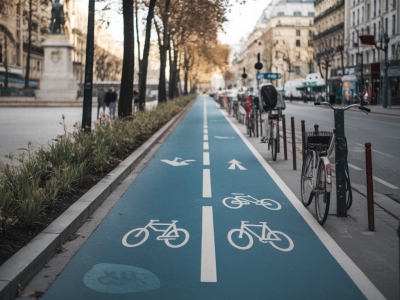
As I strolled through the bustling sidewalks of downtown Paris last spring, something curious caught my eye—a small, boxy robot, quietly humming along at walking speed, weaving carefully between pedestrians. It looked like something out of a sci-fi movie, but it was real. A sidewalk delivery robot, en route to deliver someone’s lunch. Not long after, I saw another. Then another. The question naturally came to my mind: can these robots truly coexist with pedestrians in complex urban environments?
At Mobility News, I’ve always been fascinated by how mobility is being redefined—not just in terms of cars and mass transit, but also in how items move across our cities. And sidewalk robots are reshaping an entire layer of urban logistics. But while autonomous delivery bots offer clear efficiency and sustainability benefits, integrating them into our pedestrian-dominated spaces isn’t so straightforward.
The Promise of Sidewalk Delivery Robots
Companies like Starship Technologies, Kiwibot, and Nuro are leading the way in sidewalk delivery robots capable of transporting groceries, takeaway meals, and small parcels over short distances. These bots are typically the size of a cooler, equipped with GPS, LiDAR, cameras, and an array of sensors that help them navigate sidewalks, crosswalks, and urban terrain.
The promises they carry are enticing:
- Reduced urban congestion thanks to fewer delivery vans clogging narrow streets.
- Lower emissions through electric power and local-first logistics.
- Increased delivery efficiency with cost-effective, on-demand parcel movement.
This type of innovation fits squarely into our vision of sustainable, smart cities. But when the sidewalk becomes the highway, things start getting complicated.
The Human Element: Pedestrian First
Our urban sidewalks were designed for people—individuals walking their dogs, parents with strollers, elderly citizens, runners, tourists. Sidewalk robots, while well-behaved, introduce a foreign element into this very organic choreography. Their presence raises some very human questions:
- What happens when a robot meets a crowd?
- Can these bots detect and yield to people with disabilities or reduced mobility?
- Who is responsible when a robot causes an accident—or simply becomes an obstruction?
I’ve spoken with urban planners who express concern about treating sidewalks as a new frontier for automation. Placing delivery efficiency over pedestrian experience could result in cities that prioritize tech over human well-being—a direction we cannot afford to take blindly.
Regulatory Gaps and Patchwork Policies
In the U.S., sidewalk robot regulation varies by state, or even by municipality. In the UK, where I’m based now, pilot programs are underway in places like Milton Keynes, but there is still no unified national policy. This fragmented approach makes it hard for developers to scale, and for the public to know what to expect.
Some cities, like San Francisco, have instituted strict regulations or even temporary bans after public backlash. Others, like Tallinn (Estonia), have embraced the technology wholly. But the patchwork only underlines one reality: we’re still figuring this out.
What’s missing is a coherent regulatory framework built on principles such as:
- Pedestrian priority rights on all footpaths.
- Clear speed and size limits for sidewalk robots.
- Standardized safety and navigation protocols.
- Liability structures in case of malfunction or harm.
Striking a balance between innovation and inclusion is no small feat, but it’s necessary if we want these technologies to support—not undermine—our public spaces.
Designing with Inclusivity in Mind
From a design standpoint, the sidewalk robot of the future must be empathetic. It must understand its environment not just through sensors and AI, but also by adhering to social norms. This idea, often called "social navigation", is one of the hottest areas in robotics research today.
A few promising features some startups are testing:
- >Visual indicators (like blinking lights or “eyes”) that make bots more predictable to humans.
- Audio cues to alert nearby pedestrians.
- Voice-interaction capabilities allowing people to communicate directly with the bots in simple terms.
- Geo-fencing technologies that prevent bots from entering crowded or sensitive zones such as schools or hospitals.
An intriguing project I recently discovered is from the University of Oxford’s Mobile Robotics Group, which is exploring how behavioral mapping of urban environments can help bots adapt to “invisible etiquette” rules we all follow without thinking: stepping aside for someone faster, not blocking building entrances, and so on.
Urban Infrastructure: Still Catching Up
Ultimately, whether sidewalk robots can coexist harmoniously with pedestrians also depends on the quality of the infrastructure we provide. Many sidewalks are too narrow, cluttered, or poorly maintained to accommodate extra traffic—robotic or otherwise.
One idea that's been floated (no pun intended) is to develop dedicated “slow lanes” along sidewalks for robots and micro-mobility options like scooters. Similar to bike lanes, these would buffer traffic types efficiently. But such construction demands political will, budget allocation, and public consultation—factors that can delay implementation for years.
In the meantime, pilot programs are essential. They offer real-world data, public feedback, and key opportunity for iteration. Cities like Pittsburgh and Toronto are already running controlled trials, placing a heavy emphasis on community feedback. These programs are revealing not just how robots perform, but how the public reacts to them emotionally and culturally.
Where We Go From Here
As someone who’s spent a career studying urban systems and now reports on tomorrow’s mobility, I’m both excited and cautious about sidewalk delivery robots. Innovating on the “last 300 meters” of delivery logistics is critical—especially as e-commerce and instant delivery continue to soar. But that innovation must walk hand-in-hand with empathy, inclusivity, and robust public oversight.
It’s easy to be enamored by technology’s potential. And yet, it's even more crucial to ensure our walking spaces remain human-first. Because at the end of the day, the sidewalk is one of the last truly democratic spaces in a city—where everyone, regardless of age, ability or purpose, should feel safe and welcome.
What do you think? Would you be comfortable sharing your sidewalk with a delivery robot? I’d love to hear your thoughts.

